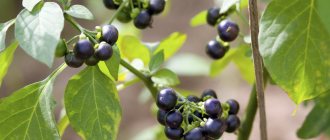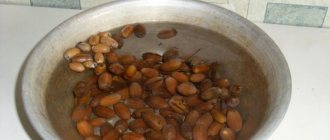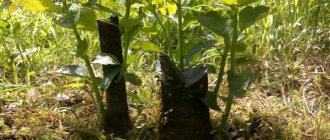Varieties
Blueberry bush in a coniferous forest
The common blueberry belongs to the heather shrubs; it has no varietal division. The plant is not specially cultivated; breeders are not specifically engaged in breeding hybrids that would be distinguished by high yields or have higher characteristics in terms of frost resistance or other indicators. The reason for this is simple, blueberries are found in different climatic zones, the main condition for its growth is sufficient soil moisture and acidity.
Blueberry grows and develops best in coniferous forests; it can often be found in mixed forests. It has been noted that the bush will develop better near the pines. This is explained by the fact that blueberries love the same acidic soils as pine, and this is the secret of their friendship.
Some taiga residents claim that there are shrubs with white fruits. But such cases were not recorded in photographs or videos.
The official name of blueberry in the directory of herbs and plants is Vaccinium myrtillus, which means common blueberry. The shrub should not be confused with blueberry; their Latin names are almost identical, but they are completely different plants.
Description of the plant
A northern berry that grows wild even in the Arctic Circle. Most often, the berry grows next to pine trees. Although it is also celebrated in mixed forests. Blueberries have similar requirements for conditions as pine trees: they love humidity, close proximity to groundwater, and partial shade.
The low-growing perennial develops as a deciduous shrub. A representative of the Lingonberry family is valued for its healthy and very tasty berries. The berry plant has a powerful, strong rhizome. It is quite branched, but the small roots go only 5-10 cm deep. Since there are a large number of them, the bushes sit tightly in the soil.
The ground part of blueberries is represented by several thick central shoots, colored brownish. On their surface there are characteristic grooves through which water flows to the roots. Side shoots extend from the trunks at an acute angle, which over time turn from green to woody. The height of the bushes is influenced by the species and varietal affiliation. On average, the parameters vary between 50-100 cm.
Oval, alternate leaf plates with serrated edges are attached to the shoots using short petioles. Their color changes during the growing season from green to red. Flowering, when the shoots are covered with inconspicuous pinkish-green flowers, occurs at the end of spring. The flowers are solitary, formed by five petals, ten stamens and one pistil. Since they are inclined, the flowers are not afraid of dampness. Pollination requires the participation of bees or bumblebees.
Blueberries enter the fruiting phase depending on the variety. Early ripening forms begin to produce oval or round berries with a diameter of 06-1 cm at the end of July. And the later ones bear fruit until September. The fruit is dark blue, almost black. The pulp is purple in color and juicy. The top is covered with a thin skin with a bluish coating that can be easily wiped off by hand. The seeds are very small.
Today, thanks to the work of breeders, the once wild blueberry has a cultivated form
Popular garden varieties of blueberries, which are often found in summer cottages:
| "Legacy" | With proper planting and proper care, the shrub grows up to 1.5-2 m. It bears fruit consistently with tasty berries. |
| "Bonus" | The variety was bred for regions with harsh winters (Siberia, Ural). In addition to winter hardiness, it is valued for its stable productivity. From one bush you can get up to 5 kg of tasty and juicy fruits. |
| "Bluecrop" | The result of crossing blueberries and blueberries. The shoots can reach a height of 2 m. The berries are large and have a pleasant, tart taste. The yield per bush is about 9 kg. Breeding development is drought- and frost-resistant. But it does not tolerate humidity well. |
| "Top Hut" | Short representative. Growing blueberries of this variety is also possible in containers on the loggia, since the maximum height of the bushes is 40 cm. The berries are large, juicy with a pronounced aroma. |
Application
Picking blueberries is a troublesome task; small berries are tightly attached to the stems by their stalks. But the beneficial substances contained in the berries will become a lifesaver for many diseases. Blueberry fruits are indispensable for colds, purulent sore throats, and vision problems.
Frozen blueberries
Traditional medicine uses not only the fruits; the branches and rhizomes of the bush are considered healing.
The collected berries are carefully sorted from debris, stalks and leaves are removed. Further processing can be of several types:
1 Blueberries are canned. The berries make delicious compotes, the main thing is not to put a lot of berries in jars, otherwise the wrapping will be cloying. For a 3-liter jar, 1/5 of the capacity of berries is enough for the preparation to be tasty and have a rich color and taste. Jams and marmalade made from blueberries are excellent; to prepare them, it is better to use fully ripened berries, which are usually rubbed through a sieve to obtain a uniform consistency, and then boiled with sugar to the required state.
2 Blueberries freeze well. The collected berries are sorted, washed, and lightly dried. Place in small portions in the freezer for several hours. After this, they are collected in containers for further storage. Sometimes freezing is carried out on berries already crushed and mixed with sugar in special containers; such a product will be inferior in the content of useful microelements and vitamins to blueberries frozen whole.
3 In a non-standard way, blueberries are stored in glass containers of any size. To do this, the containers are thoroughly washed, dried and baked in the oven for several hours. After this, the prepared berries are poured into the container, the container is sealed and filled with wax. Store glass containers with berries in a cool, dark place; the shelf life can reach six months.
Rhizomes and stems are harvested for medicinal purposes during the same period as the berries. They are dried in a suspended state in the shade or partial shade. This cannot be done in the sun; all the beneficial properties of the plant will simply evaporate.
The pharmaceutical industry uses both fresh and dried berries. Blueberries are included in many medications to improve vision, anti-inflammatory and immunomodulatory drugs for children and adults.
Some manufacturers of fat-burning dietary supplements and other drugs for cleansing the body and losing weight use the aerial part of blueberries. Branches and leaves help cleanse the gastrointestinal tract of toxins and other harmful deposits, normalize liver function, and relieve inflammatory processes in the internal organs of the human body.
Harvesting
The first blueberries begin to appear in June. The bushes bear fruit until early autumn, including September. During this entire time, you can periodically harvest.
It is recommended to pick berries every 5–10 days. The fruits ripen unevenly. Ripe berries are blue-violet and black. It takes no more than 8 days for unripe fruits to ripen. The berries do not fall off, but turn at the base. This method helps avoid damaging them. Berries can be stored at zero temperature for 6 weeks.
Picking blueberries by hand
Blueberries are harvested at the peak of their usefulness - from mid-July. Blueberries in the forest hide in lowlands with swampy soil, but the very first berries ripen on forest edges and clearings.
Blueberries should only be picked from bushes no older than 15 years: the fruits of such plants contain the maximum amount of healing substances, which are the benefits of blueberries. In wild plantings, the age of a bush is determined by the number of side shoots on it. How to pick blueberries? Collection is carried out in dry weather, in the morning or evening. Only ripe, healthy and undamaged dark blue, almost black berries are picked and placed in wicker baskets or plastic containers.
Blueberry harvesters
To speed up the collection of blueberries by 3-4 times, there is a fruit picker, or combine, that looks like a scoop. It is inexpensive, and therefore is very popular in those places where blueberry picking has become a seasonal business. This combine is a box, on the bottom wall of which is attached a “comb” with long curved teeth located at a distance of 5-6 mm from each other. Branches, leaves and shoots of blueberries easily pass between the teeth and are not damaged, and the berries end up in the container. Blueberry harvesters are made from metal, plastic and wood, and wire is used to make the teeth. You can make such a device yourself.
Blueberry storage
After harvesting, blueberries are cleaned of stalks, leaves, twigs, green berries and other debris. To do this, the berries are filled with water: the ripe blueberries sink to the bottom of the container, and the debris floats up. However, this cleaning method is not ideal, and after it you still need to peel the blueberries manually. The berries are stored dried or frozen, as well as in the form of jam.
To dry, the berries are scattered in a thin layer and placed in an oven or oven, where they are kept at a temperature of 40-50 ºC until completely dry, shaking from time to time. Store dried berries in wicker, cardboard or wooden containers in a dark, dry place.
Useful properties of cloudberries, cultivation and care
If you have a large freezer, place the washed and dried blueberries on a flat tray in a single layer and place it in the freezer. If the tray is metal, be sure to line it with a paper kitchen towel, as contact of blueberries with metal is highly undesirable. Blueberries are frozen for 2-3 hours. After this time, remove the frozen berries from the freezer, pour them into a zipper bag, zip and place the bag in the freezer. In this form, blueberries can be stored for one year.
For longer storage, washed and dried blueberries are placed in glass jars, which were heated in the oven for several hours. The jars are sealed with stoppers, which are filled with wax. Store these blueberries in cool, dark places.
Landing Features
Not everyone wants to go to the forest to pick blueberries; sometimes there just isn’t enough time. Gardeners have found a solution to this problem; blueberries brought from the forest with rhizomes can be planted on your own plot. The main thing is to approach this process competently.
Blueberries are more comfortable in partial shade
In order for blueberries to take root faster and begin to bear fruit as soon as possible, you need to know some of the nuances of planting:
1 It is better to plant prepared plants in the fall, in September-October. During this period, the shrub takes root better in a new place and puts out roots more actively. Transplantation can be carried out in the spring, but according to experienced gardeners, plants are not accepted well and often get sick.
2 It is necessary to prepare the soil in advance; blueberries will not grow on any soil. Acidic soils will provide the plant with everything necessary for development and fruiting.
3 The selection of location will also be important ; sunny areas with drafts on hills are not suitable for the plant. Blueberries prefer partial shade with high humidity.
To make blueberry bushes take root faster and better, pre-oxidize the soil with sulfur. Only 50-60 grams per square meter is enough, the powder is scattered over the surface and mixed with the top layer of soil, then watered well.
Disembarkation
Having chosen a place and previously prepared the soil, they begin to plant plants. To do this, healthy blueberry bushes with a well-developed root system are carefully selected. It is advisable that the planting material be 2-3 years old, then next season the garden pet will delight you with the first harvest of healthy berries.
Single row planting method
It is possible to plant plants with a longer life experience, but such specimens take root less well; the first few years the berries will be small, and the plant may die from minor unfavorable conditions.
Young shoots, which are obtained by seed propagation of blueberries, are also planted. They will require more careful care, but they will be able to adapt much faster.
In the second year after planting, each gardener will receive a full harvest of berries, which will depend on many factors described above.
Selected bushes are planted using standard methods for all plants of this type:
- The two-row planting principle is based on planting plants in two rows, with a distance of at least 0.5 meters between the rows and 0.7-1 m between the trunks. The next two rows are planted at a distance of about one and a half meters, this will allow the blueberries to grow and do not get confused by branches.
- The single-row method is the most common; plants are planted in one row, 70 cm apart from each bush. About a meter is left between the rows; this will be enough with this planting method.
The planting basics will be standard for each method:
1 First of all, you need to dig a hole, usually its size is 150x150cm and no more than 60cm deep.
2 Place a bush with a lump of earth in the hole and cover it with earth.
3 It is necessary to compact the soil around the plant; it is better to do this with your hands in order to fully control the process and not damage the trunk.
4 The next step is watering, it should be moderate.
Before planting, it is imperative to moisten the root system of the seedling; experienced gardeners claim that it is with a wet earthen lump that blueberries are accepted faster and better.
Further care consists of possible watering; it should be carried out if necessary, if the autumn was extremely dry. It is enough to pour about 5-7 liters of water under one bush.
Soil selection
As already mentioned, blueberries cannot grow in every soil; the bush prefers acidic soils. What to do if the type of soil on the site does not meet the requirements, and you don’t want to give up growing blueberries?
Not every soil is suitable for blueberries
In such cases, you can oxidize the soil yourself; this process is not complicated. Its implementation will not require any special material costs.
To artificially oxidize the soil for blueberry use:
- peat
- sand
- oak leaves
- sawdust
- sulfur powder
- cleaning vegetables and fruits
There are several methods used to prepare the soil for shrubs:
- Crushed peat is mixed with garden soil in a ratio of 1:2 . This layer of soil should lie 50-60 cm deep in those places where blueberries are planned to be planted.
- For poor soils, a soil mixture of peat, river sand and garden soil is suitable. The ingredients are taken in equal proportions and mixed thoroughly. The soil depth should be at least 40 cm.
- Oak leaves and sawdust will also do a good job of oxidizing the selected area. They are mixed with garden soil in a ratio of 3 parts earth to one part sawdust with leaves. Additionally, they dig up the area using a spade to mix the soil mixture again.
In each of the above oxidation methods, it is advisable to add ¼ teaspoon of sulfur for every 10 kg of soil mixture. This will additionally fill the planting site of blueberry bushes with an acidic environment.
After preparing and laying the soil mixture, it is necessary to water the planting area. To do this, prepare a solution from any food acid and water; for every 10 liters, take a tablespoon of kitchen product. To maintain an acidic environment, you can use the same solution for irrigation; use it no more than once a month.
The necessary conditions
For blueberry growing to be successful, it needs to be provided with suitable conditions. The correct choice of variety depending on the climatic conditions of the region will help to grow the crop.
Climate
There are many domestic plant varieties that can be grown in different climates. The bushes do not suffer from exposure to low temperatures in winter.
If there are less than 40-50 days between harvesting and the onset of cold weather, early frosts down to -10 degrees can cause damage to the bushes. At the same time, late spring frosts are unlikely to harm the plant, since blueberries bloom in the second half of May.
Illumination of the area
Under natural conditions, blueberries grow in pine forests. Garden varieties should be planted in sunny areas or partial shade.
Soil composition and acidity
The plant loves fairly moist soil. In this case, it is advisable to choose soil with an acidic reaction.
Favorable and undesirable neighborhood
When growing blueberries in the country, it is not recommended to plant them near fruit and berry crops or vegetables that require the use of active organic matter for fertilizing. A good option would be coniferous or deciduous trees that do not require the use of fertilizers.
Reproduction
Blueberry plantation
You can grow blueberries for planting in the garden in the following ways:
- from seeds, but fruiting will begin no earlier than the third year of growth in a permanent place in open ground
- With cuttings and berries, the bush will delight you in the second year if all recommendations are strictly followed
- by dividing the bush, the first flowering and black berries will appear within a year
Each method will require a certain period of time and full dedication to the process. Only by investing your soul can you get an excellent result in this matter.
The last two methods are considered the most common; they are easier and faster to carry out, and the work is carried out with ready-made plants. The seed method is more labor-intensive; it is important to select berries of excellent quality and carry out all stages of the procedure correctly.
Dividing the bush
This method of propagation is most popular among novice gardeners; it is simple to carry out and does not take much time.
Inspection of the rhizome
The process consists of the following main steps:
1 Since spring, the gardener has been looking for healthy and well-developing options among the bushes.
2 After harvesting, the mother bush is dug up
3 Carefully inspect the above-ground part of the plant and rhizome
4 If the condition is satisfactory, separation is carried out using a shovel or sharp knife.
5 It is advisable to treat the sections with crushed charcoal and let them dry slightly
6 Immediately after this, they land on the prepared site.
7 Water generously
When dividing the bush, pay attention to the fact that each part gets 5 healthy, well-developed branches!
It is extremely undesirable to carry out division in the spring; this can lead to the death of both parts of the trunk. Experts recommend carrying out the procedure in August-September, then the new bushes will be able to take root before the onset of winter.
Cuttings
Reproduction by cuttings
Cuttings are a fairly popular way to increase the number of blueberry bushes on a site.
To carry out the procedure correctly, you need to know the following nuances:
- material for cuttings is prepared at the end of summer; spring and autumn branches are much less accepted
- For rooting, special containers are usually used, into which peat or a mixture of sawdust and peat is poured.
- It is important to keep the soil moist
- using film or glass to create a greenhouse effect for faster rooting
It is also possible to grow cuttings in open ground using a greenhouse. Peat or sawdust is also used for this.
The process of germination of cuttings goes like this:
- prepared branches can be kept in a weak solution of potassium permanganate for a couple of minutes to neutralize the cut
- Using a twig, make shallow holes and place the cuttings there
- lightly water and compact the soil around
- covered, creating a greenhouse effect
The cover is periodically removed, allowing access to fresh air and preventing rotting of the planting material.
In a couple of weeks, the sprouts will put out their first roots, and after a month they can be transplanted to a place for wintering . If propagation by cuttings is carried out in containers, they are kept outside until frost sets in, and then brought into a bright room, the temperature in which is 5-10 degrees Celsius. In the spring, as soon as the ground thaws and warms up a little, the cuttings are planted in prepared soil. If necessary, young bushes must be watered, but water stagnation should not be allowed.
During wintering indoors, the cuttings must be provided with moisture. To do this, watering is carried out as the soil dries, but not more than once a month.
Propagation by seeds
Growing blueberries from seeds
This method is rarely used, but is excellent for obtaining healthy shrub trunks.
The seed propagation method includes several stages:
- First you need to get the seeds. To do this, choose large, attractive-looking fruits from healthy branches, no older than 5 years old.
- The fruits are washed, dried and ground into a homogeneous puree. Then add water and mix thoroughly.
- After this procedure, the empty seeds float to the surface and are drained along with water and diluted juice. At the bottom there will be high-quality seed material, which will be used.
- It is advisable to dry the extracted seeds a little and place them in a weak solution of potassium permanganate for a couple of hours, and then sow them.
- Sowing is carried out in pre-prepared containers with soil, the basis of which is peat. The crops are watered and covered with film or glass to stimulate faster germination.
If everything is done correctly, after 14-20 days the first sprouts will appear in the containers. As soon as this happens, the film or glass is removed and the container is placed in a bright, warm place.
In winter, blueberry “seedlings” must be placed in a bright place with a temperature no higher than +10 degrees. In the spring, young animals are dumped into open ground or individual containers. Over the course of the summer, future blueberry bushes are grown and planted in a permanent place in the fall, no later than the beginning of October, so that they have time to take root and overwinter normally.
What year do blueberries bear fruit after planting?
The first blueberry harvests after planting the bushes begin to be harvested after three years. Therefore, it is recommended to transplant three-year-old seedlings to a permanent place of growth. The plant reaches its maximum productivity at the age of 7-10 years. Bushes aged 14-16 years practically cease to bear fruit, so the plants undergo anti-aging pruning.
Care
Blueberries, like any other garden plant, require care. Only with proper supervision will the bush bear fruit abundantly every year.
Good harvest as a result of proper care
Under natural conditions, no one takes care of blueberries, but the bush blooms every year and produces good harvests.
In the garden, blueberries will need a minimum of attention, you only need:
- periodically prune
- water as needed
- apply necessary fertilizing
- pick ripe berries on time
In addition, an important point will be periodic loosening of the soil around the bush and mulching the soil in order to retain the required amount of moisture.
Loosening must be done very carefully so as not to damage the root system of the plant, which is located in the top layer of soil.
Trimming
The blueberry bush periodically needs to be rejuvenated, old and dry branches removed, then the berries will be larger and fruiting will be abundant.
Pruning is an essential part of plant care
It is important to carry out this procedure correctly and in a timely manner; the basic rules are as follows:
- The first pruning begins on bushes that have reached 3-4 years old
- the procedure is carried out in early spring, before the sap flows along the branches and the buds begin to bloom
- after a thorough examination, the first step is to remove old, diseased, damaged and dry branches
The formation of a bush occurs according to the rules from 6-8 healthy branches, which are the basis of the trunk; the remaining shoots must be periodically removed.
Branches older than 4 years are cut out completely, this will give younger shoots the opportunity to develop, but there are some tricks here too. If a lot of shoots have formed, they must be removed, leaving no more than 5. If this is not done, allow more branches to develop, gradually fruiting will decrease significantly, the berries will become small.
Standards that have been growing in one place for more than 10-12 years are subject to rejuvenation. In early spring, the entire ground part of such specimens is cut off, leaving 20-centimeter twigs. Gradually, the bush will give new shoots, of which no more than 6 need to be preserved. After 2-3 years, the young branches will give their first harvest, it will be much larger and more abundant than the previous one.
Pruning is carried out in the spring, but only after the threat of frost has passed. Some gardeners practice pruning in the summer, but it is not advisable.
Watering
Blueberries are moisture-loving plants; for their normal growth and development, it is necessary that the soil under the bushes is always moist. Usually, it is enough to choose the right place in the garden; natural watering will be enough for the shrub.
If the summer turns out to be hot or the blueberries on the plot grow in the sun, watering must be done regularly, but you should not over-water it. This can lead to rotting of the rhizome.
Blueberries love moisture
When the soil dries out in partial shade, water the blueberries once a week; it is advisable to add food acids to the water when watering, in this way the soil will additionally oxidize and the plant will receive the necessary dose of moisture.
If the shrub grows in an area open to the sun, watering is carried out more often, 2-3 times a week. In this case, it is not necessary to add acids every time. In addition to watering blueberries, when growing blueberries this way, you will also need spraying. During the hot period, it is carried out at least a couple of times a day, generously spraying water over the bush plantation.
As the temperature decreases, the frequency of watering is reduced, but the condition of the soil is monitored and it should not be allowed to dry out.
It is also not recommended to flood blueberries; plants react poorly to stagnant water. The leaves on the trunks begin to turn yellow, then they fall off. If you continue watering, the berries will also fall off, this will already be a warning that the roots of the bush are rotting.
Fertilizing
For normal fruiting and active development, blueberries in the garden must receive all the necessary minerals and trace elements. They will provide the shrub with the strength to flower and produce a crop.
Timely and correct application of fertilizing is the key to a good harvest.
To ensure that the berries do not become smaller and fruiting is abundant, blueberries must be fed. The plant responds well to both mineral and organic substances, the main thing is to apply them correctly and in a timely manner.
From organics used for blueberries:
- manure
- compost
- peat crumbs
They are applied at intervals of 3 years, and the quantity depends on the quality of the soil. Usually 3-4 kg per square meter of area is enough. After this, it is advisable to water the fertilized area, and the day before, it is necessary to loosen the top layer of soil before applying fertilizing.
The following minerals are used for blueberries:
- superphosphate
- ammonium superphosphate
- potassium magnesia
Particular attention is paid to the acidity of the soil; if the indicators are insufficient, it is recommended to periodically apply 50-60 g of powdered sulfur to each bush annually in the spring.
Mulching will help regulate acidity. If you regularly use sawdust for this purpose, you will not need to use sulfur. In order for the acidity of the soil under the blueberry to be normal, the mulch layer should be at least 10 cm.
A mixture of sawdust and peat will give a good result; it will not only prevent the evaporation of moisture, but will normalize the acidity of the soil around the blueberry bushes.
Do not forget to periodically loosen the mulch, allowing air access to the top layer of soil.
Harvesting
One of the important components of shrub care is the timely harvest of ripe crops. The ripening period for blueberries is long; it begins in mid-June and can last until the end of August. The berries ripen and fill at intervals of 7-10 days.
Berries must be picked carefully without damaging them.
Ripeness indicators are:
- rich blue, almost black color of the fruit
- large berry size
You should not pick blueberry fruits as soon as they darken; after the color change, at least 7 days should pass until they are fully ripe.
The berries are picked carefully, trying not to damage them. Usually the fruit is pinched between the thumb and forefinger and twisted slightly, this way it will move away from the branch better and faster without getting damaged.
The trunk does not require care during the winter period . Blueberries are frost-resistant plants; they are not afraid of winter cold even in the Arctic. That is why the bushes are not covered for the winter; it is enough to lightly cover the soil around the bushes with fallen leaves. This will preserve the plant’s root system and add additional acids to the soil.
Site requirements
Blueberry
Blueberries grow well in acidic, loose soil. The area should be slightly shaded. Growing blueberries in the garden is also possible in an open sunny area, but then you will need to additionally moisten the leaves of the bush in the summer.
If you plant young bush blueberry seedlings in ordinary soil, the plant will develop poorly, and sometimes the bushes die.
The cottage must be protected from constant drafts.
Planting blueberries in spring
The garden is prepared in advance. Seedlings are planted in open ground in autumn or spring. Blueberries are planted in the spring when there is no threat of frost. It is preferable to choose the autumn season for planting bushes. The golden mean will be October. Bushes planted in October take root faster in a new location.
Autumn planting is done in October or early November, fertilizers are applied in September.
Recommendations for soil preparation, how to grow blueberries:
- Dig a hole measuring 150x150x60 cm;
- Mix the soil from the holes with peat in a 2:1 ratio;
- Add a little powdered sulfur to the soil mixture to acidify the soil;
- If the soil is heavy, then river sand or rotted oak leaves are added to the soil.
The resulting soil mixture is similar to the soil in which blueberries grow under natural conditions.
On a note . Before planting, it is recommended to test the soil for composition and determine the acidity level. After obtaining soil data, all necessary additives are added to the soil. The main condition for the soil for blueberries is that it must be acidic. You can acidify the soil with organic matter or special preparations.
Diseases and pests
Improper care of a plant can cause a spider mite attack.
Blueberries are not afraid of pests and diseases; the bush has strong immunity to most diseases. Sometimes, with improper care and untimely pruning of old branches, the trunk can be attacked by spider mites. There are several ways to combat this:
- carefully inspect and remove all diseased branches on the bushes
- treat the stamps with products from stores
Subsequently, in order to prevent the appearance of ticks, it is necessary to promptly prune the branches and carefully clear the bushes of old specimens.
Excessive watering and poorly drained soil can cause root rot. The only way to combat this is to dig up diseased bushes. It is possible to prevent the disease; it is necessary to strictly observe the watering regime and carefully examine the condition of the soil before carrying out the procedure. If the soil is sufficiently moist, it is better to postpone watering for a couple of days.
Beneficial properties of blueberries
Blueberries have the following properties:
- cardiotonic,
- vasodilator,
- anti-spasmodic,
- astringent,
- antiemetic,
- carminative,
- diuretic,
- choleretic,
- antiseptic,
- antibacterial,
- antibiotic (berries),
- painkiller,
- anti-inflammatory,
- hemostatic,
- antiputrefactive,
- hematopoietic,
- tonic,
- restorative,
- antiscorbutic,
- vitamin
Important! The information presented in the material is for informational purposes only. Before use, be sure to consult a specialist.
Blueberries in the landscape
Blueberries are not often found in landscape design.
Nowadays, landscape designers use a variety of plants to create a unique and individual look in each courtyard. Increasingly, they are turning to natural plants. Which grow without problems in all latitudes, and blueberry is one of these.
Blueberry bushes planted in a specific sequence will help create the most incredible ideas for landscaping a yard or a specific area of the garden.
Most often, blueberry is used for landscaping in shady places; it goes well with conifers and creates a living carpet under the trees. Sometimes several blueberry bushes can be used in flower beds; bright berries will highlight the greenery of other plants.
Growing blueberries on your property is not difficult; the bush will be an excellent decoration for any garden, and will also provide the whole family with healthy and tasty berries.
VIDEO: Blueberries - beneficial properties
Description of varieties and varieties of garden blueberries
The culture got its name from the ability of the berries to stain fingers, lips and teeth dark.
Wild blueberry is a perennial shrub 40 cm high. It grows in coniferous, pine and mixed forests. Bushes are found in marshy areas and forest edges, often forming entire plantations.
The mass harvest of wild plants occurs in August. Wild blueberries have a more tart flavor than cultivated varieties.
The common blueberry grows in the northern temperate latitudes of Europe, Siberia and the Far East. Small bushes reach one and a half meters.
Its fruits have a sweet and sour taste. The oval-leaved species is found in the USA and Canada. The small leaves turn red in autumn.
Caucasian blueberry, growing on the slopes of mountains, is a three-meter tree. Hairy blueberry is found on the Sakhalin Islands; another variety, redberry, grows in the Ussuri region.
The types of blueberries do not end there; there are about a hundred of them in the world.
Large bush species began to be cultivated in North America about a century ago. Most often, farmers crossed blueberries and blueberries to produce larger yields of the large berry.
Modern garden blueberries contain many useful substances, while their flesh is much lighter than that of berries from the forest.
The bushes are decorative in themselves: in May they are covered with snow-white flowers, and by autumn they change color from green to yellow or red.
Popular blueberry varieties:
Blueberry "Forest Pearl"
A low-growing and frost-resistant plant, the height of the bush does not exceed 40 cm. Fruiting begins in the second year after planting. The berries are covered with a bluish coating, one weighs 10 g;
Blueberry "Top Hut"
Blueberries can be grown both in the garden and on the balcony; their height does not exceed 30 cm. The hybrid has a high survival rate. The bushes begin to bear fruit in July. The aromatic berries are large and sweet;
Blueberry "Bluecrop"
Tall blueberries, the bush reaches 1.9 m. Ripening occurs at the end of July. The berries are large, the diameter can be 20 mm. The harvest is well stored and transported;
Blueberry "Patriot"
Another tall blueberry. Compact bushes can be used in landscape design. The yield is high, 9 kg of berries are harvested from one plant. The variety is resistant to diseases;
Blueberry "Elizabeth"
The late variety is characterized by high yield. Sweet and sour berries tolerate transportation well. The bushes survive in winters with little snow, they are not afraid of drought and epidemics.
With proper care, the lifespan of the bushes is 40 years.











